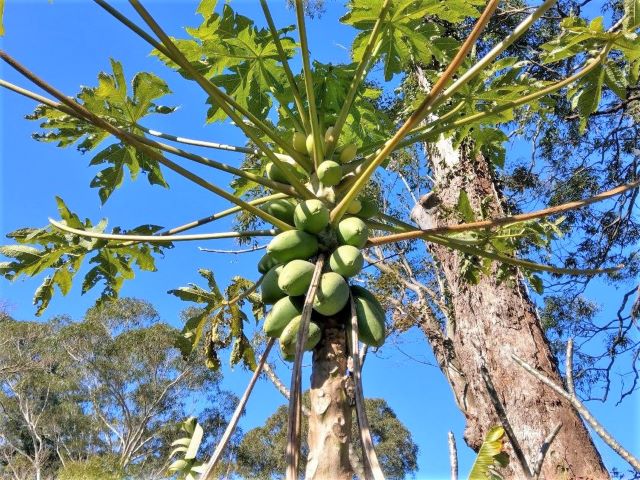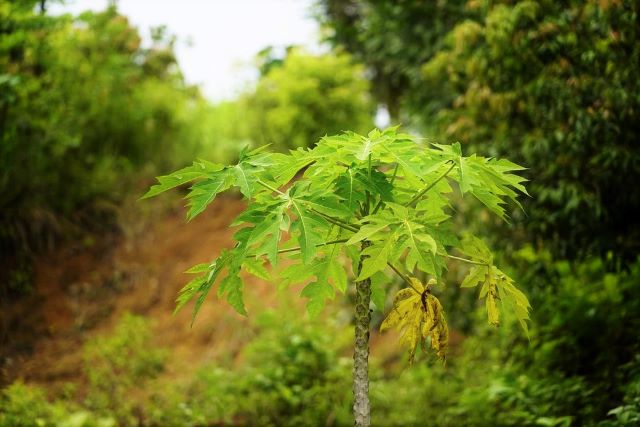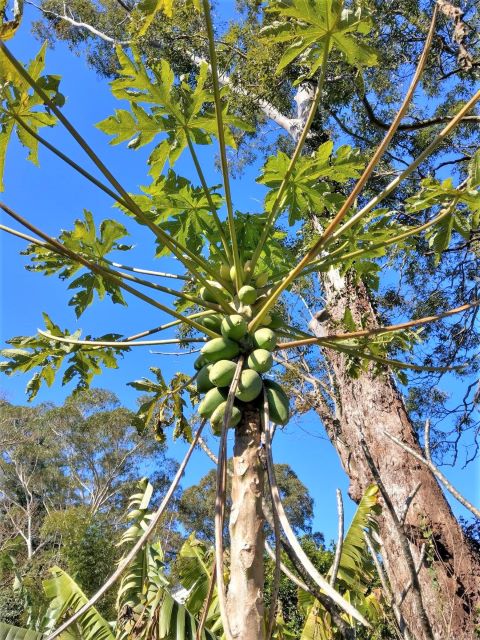Papaya trees, also known as pawpaw and papaw, are attractive and productive fruit trees to grow in your garden. So if your papaya tree looks like it’s dying or struggling to grow, you’re going to want to know why and how to fix the problem.

The most common causes for papaya trees dying are cold temperatures, high winds, lack of sunlight, incorrect watering, and insufficient soil nutrients. Some diseases and pest infestations can also cause problems and even papaya tree death.
Read on to find out the reasons why your papaya tree is dying and what you can do to get your tree back to health to produce a delicious harvest of papaya fruits.
Table of Contents
- 1. Temperature Is Too Cold for Papaya Trees
- 2. It’s Too Windy For Papaya Trees
- 3. Insufficient Sunlight Causes Papaya Tree Death
- 4. Incorrect Watering Can Cause Papaya Trees to Die
- 5. Lack of Soil Nutrients For Papaya Tree
- 6. Diseases Cause Papaya Tree Death
- 7. Pest Infestations Can Lead to Papaya Trees Dying
1. Temperature Is Too Cold for Papaya Trees
Papayas are tropical fruit trees, so they grow best in subtropical and tropical climates. For this reason, they don’t tolerate cold or freezing conditions. If the temperature drops below 31 °F (-0.5 °C), your papaya tree will suffer. Cold weather can lead to papaya tree death.
For the ideal growing climate, papaya trees are going to thrive in temperatures between 70-90 °F (21-32 °C).
If you live in the U.S. you can grow papaya trees in zones 9b-11.
So if you know you live in a climate that should support growing a papaya tree but you are expecting a cold change, consider covering your tree with some form of frost protection.
Younger papaya trees are going to be especially vulnerable to cold temperatures and may need additional protection in the first few months against the cold.

2. It’s Too Windy For Papaya Trees
Windy conditioners for prolonged periods of time should be avoided when growing papaya trees.
I’ve even had a papaya tree completely topple over after high winds! And if strong winds don’t kill your papaya tree, which they can definitely do, they will still suffer by being blown around.
So choose a protected planting location for your papaya tree, away from windy conditions.
Think about the protection provided by a nearby fence, the wall of a house or other fruit trees close by. Just make sure it will still receive plenty of sunlight, which is also vital for papaya tree growth.
3. Insufficient Sunlight Causes Papaya Tree Death

A lack of sunlight can cause a papaya tree to die. As a tropical fruit tree, papayas thrive in warm and sunny conditions. At least 8 hours of direct sunlight a day is required for the healthy growth of the tree as well as the papaya tree’s ability to produce flowers and form delicious fruits.
So choose a sunny spot in the garden to grow your papaya tree. While still protecting papayas from any potential high winds, make sure walls, fences and other trees won’t shade out your papaya tree.
Plant papaya trees at least 7 ft (2 m) from these other structures and plants so they’ll receive the sunlight required for optimal health.
4. Incorrect Watering Can Cause Papaya Trees to Die
Too much water is usually more of a problem than too little because gardeners can be a bit enthusiastic about watering. Overwatering can cause root rot and lead to your papaya tree dying.
The right amount of water for your papaya tree will depend on your climate, natural rainfall, and the type of soil you’re growing in.
In warmer climates without current rain, your papaya tree may need watering every 3-4 days.
Hold off watering during rainy periods and water much less during cooler weather. In high rainfall climates, papaya trees don’t need additional water once they are established.
Free-draining soil will not hold water for as long as more loamy soil does. Therefore you will need to water more frequently for free-draining soil and less for soil that holds water.
Mulching around the papaya tree, with an organic mulch, will also help the soil retain moisture so it doesn’t dry out too quickly. When mulching just be sure to stay clear of the trunk.
5. Lack of Soil Nutrients For Papaya Tree
The right soil conditions will help your papaya tree to grow strong and fruit well. Papaya trees prefer free-draining soil with a pH between 4.5-8 (you can test your soil to find out the soil pH with this monitor).
Although papaya trees don’t need a large amount of fertilization, they will benefit from small amounts throughout the year. I like a well-balanced organic fruit tree fertilizer like this one. Between fertilization, you can also top dress the surrounding soil with homemade compost or aged manure.
Although a lack of soil nutrients might not necessarily cause your papaya tree to outright fail, it will cause it to struggle to thrive. And of course, soil that is devoid of all life and health won’t grow anything.
So feed your soil with organic fertilizer, healthy homemade compost, and aged manures for the very best growing conditions for your papaya tree.
6. Diseases Cause Papaya Tree Death
Various diseases can affect papaya trees. A few of the more common ones to look out for include:
Papaya Ringspot Virus
Papaya Ringspot Virus can affect the leaves, the tree stems and the papaya fruits.
- On leaves, papaya ringspot virus causes mosaic colors and mottled patterns turning the leaves ruffled-like. Leaf shape and size are also affected.
- Papaya tree stems develop green streaks dark in color with a water-soaked appearance.
- Fruits develop green spots or rings, sometimes c-shaped, which enlarge and darken as the fruit grows.
In server cases, papaya ringspot virus will cause papaya tree death. Unfortunately, there is no effective control for this disease and infected papaya trees should be removed and destroyed so as not to spread the disease.
Phytophthora Blight
Phytophthora Blight is a fungal disease also known as stem canker, root rot, soft fruit rot and soft foot rot. It usually develops due to too much rain and wet conditions. This disease affects the fruits, stems, leaves and roots of the papaya tree.
- Fruits develop water-soaked lesions, they eventually rot and fall from the papaya tree.
- Stems and leaves also develop lesions. This weakens them and causes them to break or fall from the tree.
- Roots can rot and server damage can cause papaya tree death.
The best management is to ensure papaya trees are planted in free draining soil. You can improve soil structure with the addition of compost and aged manures.
Practice crop rotation. If you’ve grown papaya trees in your current spot recently, consider choosing a different planting site to help prevent the spread of the disease.
While all papaya trees can develop the disease, there are varieties that are less susceptible such as Kapaho Solo.
If you take all of these measures and still suspect Phytophthora blight, your best line of defense is to remove and destroy the tree to stop it from spreading to other plants and trees. However, if you have had this problem before and want a preventative measure, you can use an organic fungicide like this.
7. Pest Infestations Can Lead to Papaya Trees Dying
There are a number of pests that can affect papaya trees. Not all of them will lead to the papaya tree dying but they can inflict sufficient damage that will inhibit growth. They are well worth eliminating in order to ensure your papaya tree will produce a great crop for you.
Two-Spotted Mite
Two-Spotted Mite will attack the papaya tree leaves which can cause the leaves to drop. This two-spotted mite shows up as discoloring of the leaf, turning it brown. And eventually, leads to the skeletonization of papaya leaves.
For an organic solution, you can use horticultural neem oil.
Nematodes
Nematodes are a type of roundworm and are considered a plant-parasite. Pest nematodes will attack the papaya tree roots by feeding on them and over time this can lead to the tree falling over.
Just to confuse you, there are good nematodes too! Also known as beneficial nematodes who live in healthy soil and will keep the bad nematodes in check.
This pest is tricky to spot since it lives underground. Unfortunately, you might not realize you have a nematode problem until it’s too late.
The best solution is to make sure you are planting your papaya tree in healthy soil that has not previously had a nematode infestation.
Healthy soil that is amended with aged manures and homemade compost reduces the likelihood of nematodes. It also creates an environment that encourages the good nematodes who will keep the bad ones away.
Planting Marigolds also works as a natural pest deterrent – including against the pest nematodes.
You can also introduce beneficial nematodes like these ones here. They also work to control many other pests in your edible garden so they are well worth getting.
Further reading:
- Why Are My Mangoes So Small? Answered!
- Tree Tomato: Tamarillo Tree Leaves Turning Yellow (Causes And Solutions)
- Pepino Melon: How To Grow The Plant And Eat The Fruit
- Brown Spots on Avocado Leaves: Causes and Solutions
- How Many Pineapples Grow on One Plant? Answered!
- How To Grow Dragon Fruit: Planting, Caring And Harvesting
- 5 Reasons Dragon Fruit Plant Is Turning Yellow
